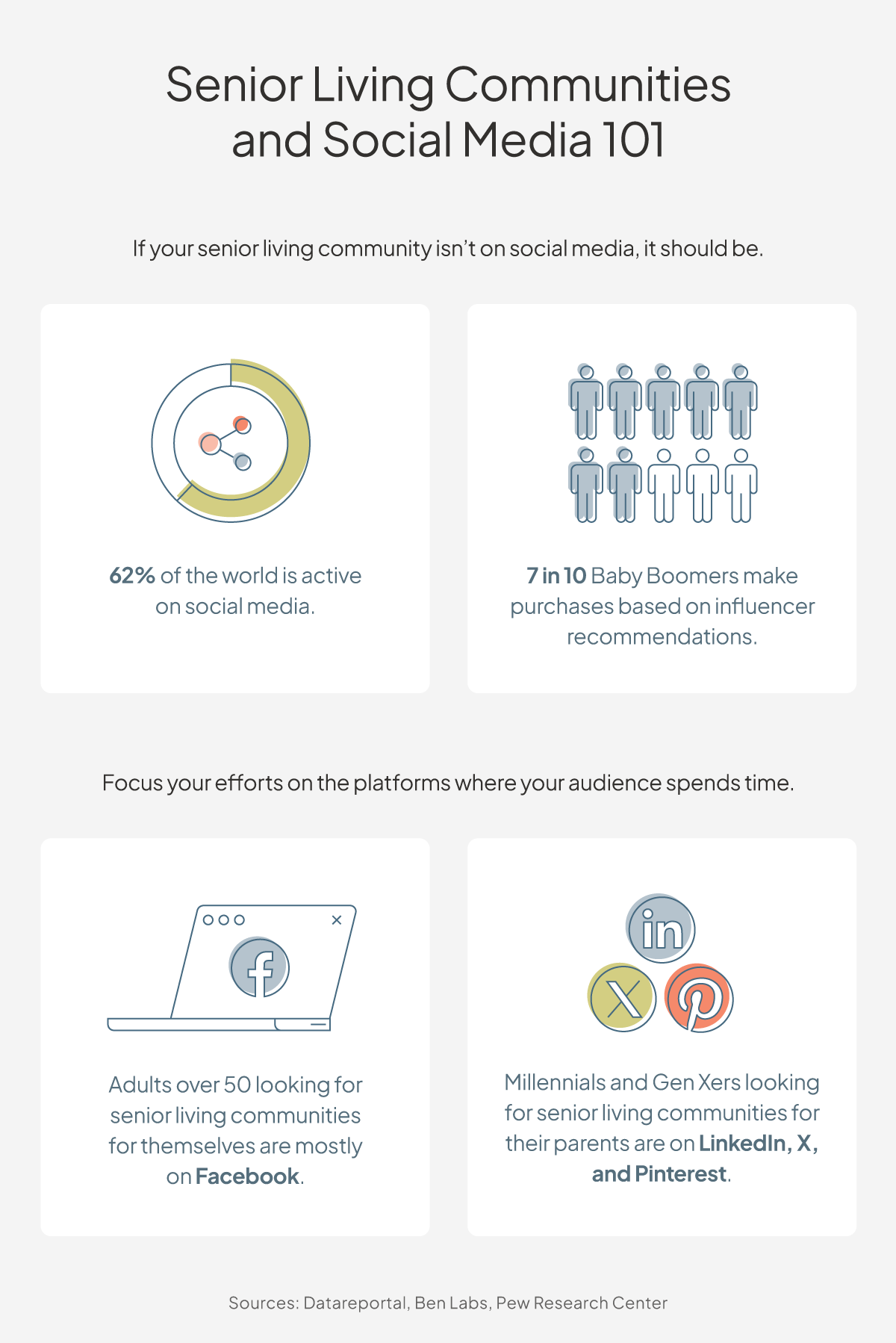How To Market Assisted Living Effectively [2025 Guide]
Use these 17 strategies to level up your marketing.

Use these 17 strategies to level up your marketing.
Published on: May 7, 2024
Last updated: September 4, 2025

Contents
If your senior living community struggles to turn leads into residents, you aren’t alone. Many operators cite this as one of their top challenges. Building a stronger marketing strategy can help you connect with the right prospects, nurture trust, and move leads forward with confidence.
Effective marketing isn’t just about getting more leads — it’s about turning interest into action. Boost occupancy and drive meaningful growth by optimizing your online presence, strengthening referral relationships, and putting proven strategies into action.
No matter how great your marketing materials are, they won’t see results if you send them to the wrong people. Understanding your target audience is the first step in marketing assisted living.
Consider the following when pinpointing your ideal resident:
To truly understand your audience:
Start by using the information you gather to create personas that guide how you build and share your marketing materials. You should target different personas with different messages tailored to their needs and preferences. And remember to update these personas frequently — generational needs continue to evolve, and today’s 70-year-olds aren’t the same as those from a decade ago.
A marketing plan is an actionable roadmap that keeps your marketing strategy on track and helps you monitor the ROI of your efforts. While every senior living community should have a marketing plan, it’s especially helpful if you have strong competition, or your occupancy rates might begin to fall.
A good marketing plan for assisted living includes:
Once you have your marketing plan in place, use it to guide all your marketing decisions.
Expert Tip: Our senior living marketing plan template can help you craft the perfect marketing plan to help you reach your goals.
The average sales cycle for assisted living is 317 days. This long cycle means prospects can easily slip through the cracks.
A powerful CRM is a must for any assisted living community. The Aline CRM helps your sales team monitor a lead’s progress through the sales funnel and increases the likelihood a prospect will become a resident.
When researching a CRM, look for:
Contrary to stereotypes, 32% of senior living inquiries stem from the web or social media, which means if you don’t have an online presence, you’re potentially cutting your lead intake by almost a third.
To foster an online presence:
While print ads in magazines or mailers can be effective marketing strategies, online assisted living advertising is often more effective and has a better ROI.
Online advertising has several key benefits, including:
There are two main types of online advertising: pay-per-click (PPC) ads and social media ads.
Pay-per-click ads show up in search results for specific keywords. Since you only pay for the ad when users click on them, they are highly effective.
For example, a user may search the keyword “caregiver tips for dementia.” If your memory care community has a PPC ad for this keyword, your page will pop up at the top of the search results.
Social media ads are another example of online advertising. These ads specifically target people whose algorithm indicates they’re already predisposed to learning more about your brand.
For example, they may follow other caregivers for people living in assisted living, so your social media ad for your assisted living community may pop up in their feed. Because they already have an interest in your offering, the ad is more effective.
Turn prospects into residents with targeted newsletters that focus on helpful information for your audience.
Aim for newsletters that are 90% informational and 10% promotional content, so recipients see the newsletters helpful rather than spam. For example, highlight public events and activities and include workout tips for seniors before talking about move-in deals.
Expert tip: Leverage a senior living CRM to automate your email marketing, so these newsletters are a breeze to send regularly.
Playing an active role in your community makes you a local resource, not just a residence.
Here are a few tips to become more involved in your community:
By engaging with your community, you make your senior living community visible to everyone, not just those who have an immediate need for your services. When they do find themselves in need, they’re more likely to turn to you since they already have a relationship with you.
Senior living communities manage a complex ecosystem behind the scenes — balancing sales and marketing, day-to-day operations, billing and leasing, regulatory compliance, care planning, and more. At the same time, leaders must also focus on keeping teams supported and residents thriving.
Managing all of this with disconnected systems only adds friction. Unifying your data and workflows in one place brings the clarity, efficiency, and insight you need to move faster and support better outcomes.
By unifying your software systems, you can:
Administrative tasks are a necessary part of managing a senior living community, but without the right systems, they can eat up more time and energy than they should.
Digital solutions can help you free up time, simplify workflows, and refocus your team on what matters most: delivering exceptional care. Here are a few simple tools that can help you streamline administrative tasks and create a smoother experience for both your team and prospective residents:
Digitizing the process helps your sales team and makes it easier for your future residents. Just ensure the apps you select integrate your systems with your existing tech stack.
If 98% of shoppers read reviews before buying a product as simple as a toaster, imagine how much reviews matter when choosing a senior living community. Online feedback heavily influences prospective resident and family decisions, and it’s essential to actively manage your reviews.
Respond authentically to reviews on sites like Google, Caring.com, or A Place for Mom. Potential residents want to know you care about how your community is viewed and how you respond to criticism.
To respond to negative reviews, offer a thank you and an apology if appropriate, and always offer to speak with the customer more in depth to solve the problem. Refrain from arguing with the reviewer and move follow-ups to a different channel, such as a phone call.
Market research shows that 64% of market source conversions for senior living move-ins come from unpaid referrals. Expanding your referral network is one of the most effective — and cost-free — ways to grow your lead base. You can strengthen your network by:
Capture leads’ attention and drive conversions with strategic video content. After all, your future residents are active on YouTube: People ages 55-plus make up almost 20% of YouTube’s audience, suggesting that seniors are receptive to video marketing materials.
When making your videos, keep them short and to the point. The average adult attention span is just over eight seconds, but the average time spent watching a single internet video is nearly three minutes.
Make sure your video has a clear message and includes subtitles, so it’s easy to watch without sound. End with a strong call to action, like encouraging viewers to schedule a visit. Once your video is ready, share it strategically on YouTube and the social platforms where your target audience is most active.
More than 62% of the world is on social media daily, so if your senior living community isn’t, it’s time to re-evaluate.
Your social media accounts should:
You can also take advantage of influencer marketing. Most baby boomers will make a purchase based on a recommendation from someone they follow on social media. Influencer marketing must be authentic, so reach out to people your audience follows, such as senior wellness influencers, and ask them to give reviews or share your content.

When creating and sharing content on social media, be mindful of where your audience spends their time:
The senior living industry is filled with alphabet soup: AL, ALF, ANP, CCRC, LTC, MC. These acronyms can confuse your leads, especially at the beginning of the sales cycle. They also make your community feel more like a medical institution than a place where they can relax, make friends, and have fun.
Focus on sharing stories with potential leads. Not only do people remember stories 22 times more than facts, but emotional connections created through narratives are known to drive brand loyalty.
Some ways to share stories include:
Video ads and social media are great for raising brand awareness, but you need face-to-face interactions to effectively move a prospect to the next stage of the sale.
Get potential residents in the door and experience what life is like in your community by:
Tours should be personable, well-planned, and include follow-up. Administer a survey afterward to find out how you can improve future tours.
The average lead response time is 47 hours, but conversion rates drop by eight times after just five minutes. The longer you wait to respond to a lead, the less likely that lead is to convert.
The solution for senior living community sales teams is to never miss a phone call or chat message, but that can be hard for your sales staff to tackle on their own. That’s where Aline Contact Center comes in.
Our Contact Center works as a virtual arm of your sales team, responding to phone and digital leads within five minutes and boosting conversions. In fact, our clients report an average of 35% increase in leads and a 20% increase in tours with the support of our Contact Center. By responding faster and more consistently, you can capture more opportunities, build stronger relationships from the very first touchpoint, and turn more prospects into move-ins.
Longer sales cycles correlate with longer stays, but keeping your communities full means consistently moving prospects through the funnel. To do that, you need clear visibility into every stage of your sales process.
A high-quality CRM can help you monitor prospect movement, track performance, and generate reports that show the true ROI of your marketing efforts. By measuring what’s working, you can focus your resources on the strategies that deliver the greatest impact.
Once you’ve explored new marketing strategies, the next step is making them easier to execute. Using sales and marketing software built for senior living can help your team move faster, nurture leads more effectively, and boost occupancy.
Book a demo to see how Aline simplifies the sales and marketing process — and helps you turn more prospects into residents.
Looking for more ideas? Download our free guide to optimizing performance with better lead generation.


Amanda McGrory-Dixon
Amanda McGrory-Dixon is the content marketing manager at Aline, where she shares expert insights on how senior living communities can streamline operations, enhance resident satisfaction, and drive sustainable growth. With a deep understanding of industry trends and technology, she helps operators navigate challenges and implement data-driven strategies to improve efficiency, profitability, and care outcomes.
Blogs, stories and studies from the forefront of senior living operations

Lead generation surveys give senior living operators the data they need to understand their market, uncover new opportunities, and drive occupancy growth.

Prospect-centered selling helps senior living operators convert more leads and achieve occupancy goals through a more personalized, empathetic approach.

Gain insight into senior living pricing strategies for community success. Explore how Aline’s software optimizes revenue and operations

Overcome the biggest senior living financial challenges, including operational costs and occupancy rates, with interconnected software

Take a look at how senior living software options, like Aline, can elevate operations, resident care, and ROI

Enhance efficiency, accuracy, and resident satisfaction by integrating a POS system into your senior living dining operations
We’re using cookies on this site to improve your experience. Cookies help us learn how you interact with our website, and remember you when you come back so we can tailor it to your interests.
You can find out more about cookies and usage on our cookie policy page.
Some of these cookies are essential, while others help us to improve your experience by providing insights into how the site is being used.
For more detailed information on the cookies we use, please check our privacy policy
Your experience is important to us. We’re redirecting you to our new Aline website, where you’ll discover how our complete suite of senior living solutions can help you grow occupancy and revenue, optimize operations, and enhance resident care.
For more information, you’re welcome to read our statement on our merger. To continue your web experience, simply close this notification.
Your experience is important to us. We’re redirecting you to our new Aline website, where you’ll discover how our complete suite of senior living solutions can help you grow occupancy and revenue, optimize operations, and enhance resident care.
For more information, you’re welcome to read our statement on our merger. To continue your web experience, simply close this notification.
Your experience is important to us. We’re redirecting you to our new Aline website, where you’ll discover how our complete suite of senior living solutions can help you grow occupancy and revenue, optimize operations, and enhance resident care.
For more information, you’re welcome to read our statement on our merger. To continue your web experience, simply close this notification.
Your experience is important to us. We’re redirecting you to our new Aline website, where you’ll discover how our complete suite of senior living solutions can help you grow occupancy and revenue, optimize operations, and enhance resident care.
For more information, you’re welcome to read our statement on our merger. To continue your web experience, simply close this notification.
Aline Innovation Summit 2026: Registration Now Open!
Connect with senior living leaders, innovators, and industry peers May 11-13, 2026, in Frisco, TX to explore the latest innovations, proven strategies, and best practices shaping the future of senior living. View details and register today.